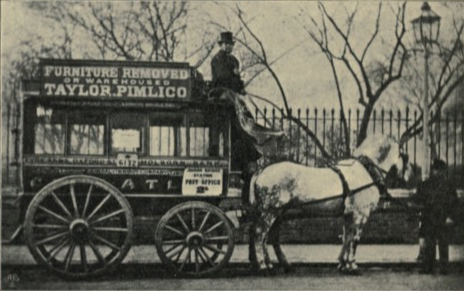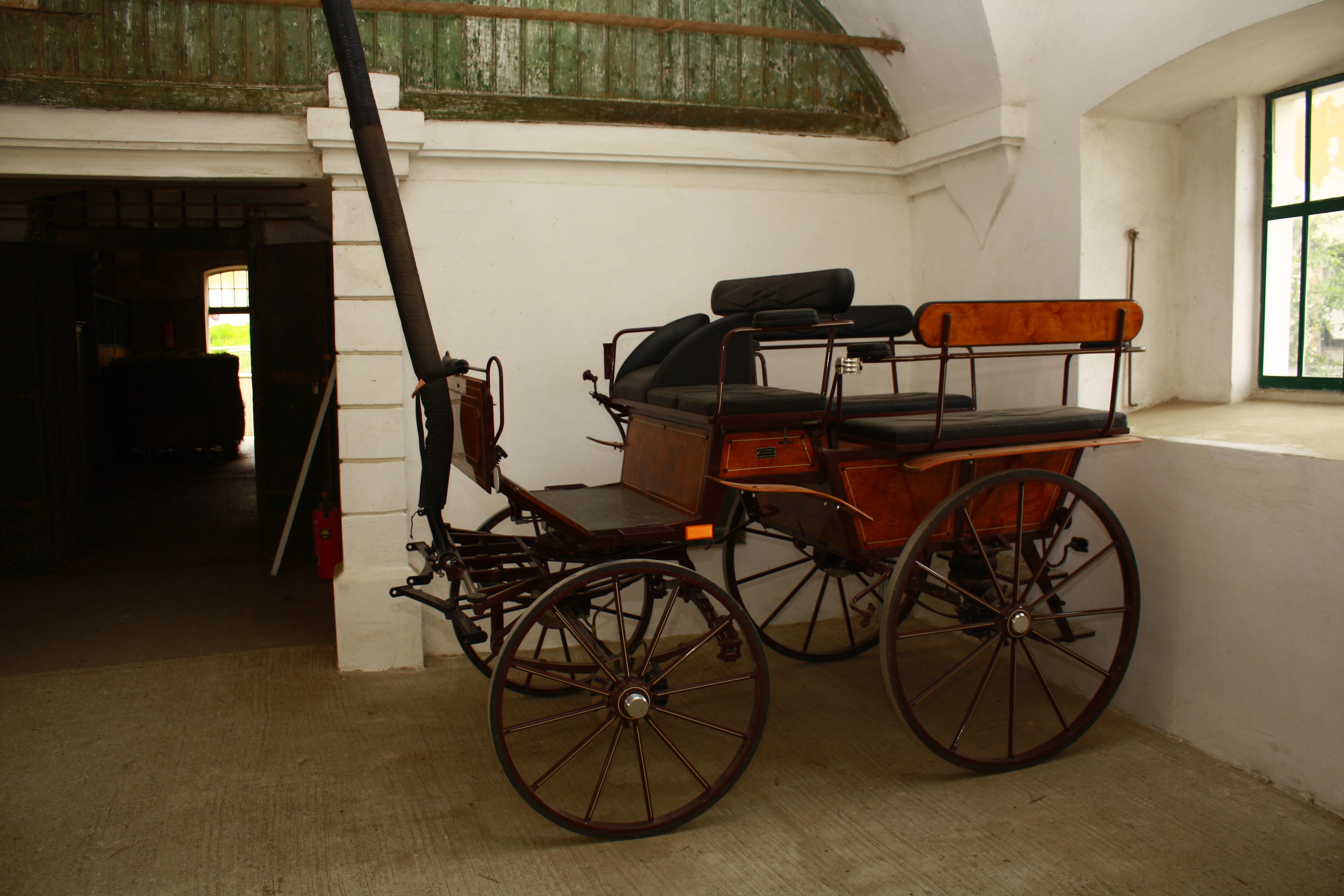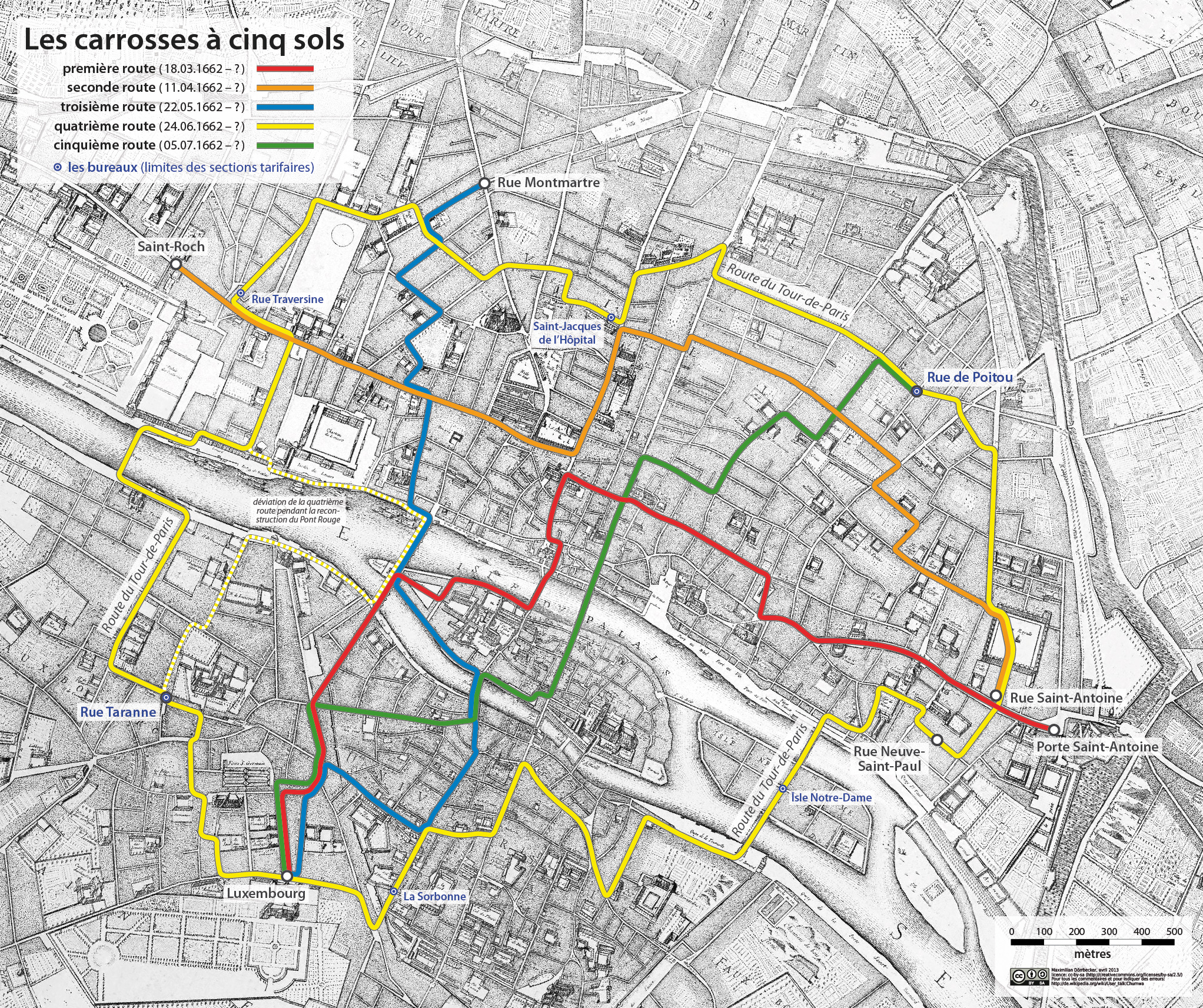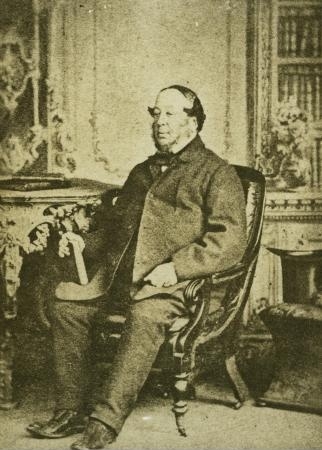|
Horsebus
A horse-bus or horse-drawn omnibus was a large, enclosed, and sprung horse-drawn vehicle used for passenger transport before the introduction of motor vehicles. It was mainly used in the late 19th century in both the United States and Europe, and was one of the most common means of transportation in cities. In a typical arrangement, two wooden benches along the sides of the passenger cabin held several sitting passengers facing each other. The driver sat on a separate, front-facing bench, typically in an elevated position outside the passengers' enclosed cabin. In the main age of horse buses, many of them were double-decker buses. On the upper deck, which was uncovered, the longitudinal benches were arranged back to back. Similar, if smaller, vehicles were often maintained at country houses (and by some hotels and railway companies) to convey servants and luggage to and from the railway station. Especially popular around 1870–1900, these vehicles were known as a 'private omni ... [...More Info...] [...Related Items...] OR: [Wikipedia] [Google] [Baidu] |
Wagonette
A wagonette (''little wagon'') is a small horse-drawn vehicle with springs, which has two benches along the right and left side of the platform, people facing each other. The driver sits on a separate, front-facing bench. A wagonette may be open or have a tilt. A large horse-drawn enclosed vehicle with spring-suspension, a similar arrangement of the seats and obligatory roof is called a horsebus. The 1914 book ''Motor Body-building in All Its Branches'' by Christopher William Terry, defined a shooting-brake as a wagonette provided with game and gun racks and accommodation for ammunition. See also * Carriage * Horsebus A horse-bus or horse-drawn omnibus was a large, enclosed, and sprung horse-drawn vehicle used for passenger transport before the introduction of motor vehicles. It was mainly used in the late 19th century in both the United States and Europe ... References Animal-powered vehicles Horse transportation {{vehicle-stub ... [...More Info...] [...Related Items...] OR: [Wikipedia] [Google] [Baidu] |
Carrosses à Cinq Sols
The carrosses à cinq sols (English: five-sol coaches) were the first modern form of public transport in the world, developed by mathematician and philosopher Blaise Pascal. History Paris in the era of Louis XIV was one of the world's most populous cities: it contained more than 500,000 residents in 22,000 residencies, 500 major roads, 100 public squares, 9 bridges. The narrow Parisian road network, dating from medieval times, did not make the establishment of public transportation attractive, but in spite of this, a few attempted to organise a modern public transit network. In a corporation founded in November 1661 on the initiative of Blaise Pascal, with the participation of the Duke of Roannez (governor and lieutenant-general of the province of Poitou), the Marquis de Sourches (knight of the king's orders and Grand Provost of the Hotel), and the Marquis de Crenan, the entrepreneurs presented a request to establish an operator for "carriages which would always make the same jou ... [...More Info...] [...Related Items...] OR: [Wikipedia] [Google] [Baidu] |
New Road (eighteenth Century North London Turnpike Road)
The New Road was a toll road built across fields around the northern boundaries of London, the first part of which opened in 1756. The route comprises the modern-day A501 ( Old Marylebone Road, Marylebone Road, Euston Road, Pentonville Road, City Road, and Moorgate). Background In the 18th century London began to grow rapidly. Until 1750 there was only one road crossing over the River Thames, namely London Bridge. But the capital started to sprawl, first along the river from the City to Westminster, and then north past Soho (in medieval times, the king's hunting grounds) to Oxford Street and beyond. The Proceedings of the Old Bailey Online Project give a good overview of the demographic growth of the capital. From the early 19th century, London was the largest city in the world. Early history In 1755 influential residents of St Marylebone, Paddington and Islington, all separate villages close to London, petitioned Parliament for the right to provide a turnpike trus ... [...More Info...] [...Related Items...] OR: [Wikipedia] [Google] [Baidu] |
Nantes
Nantes (, , ; Gallo: or ; ) is a city in Loire-Atlantique on the Loire, from the Atlantic coast. The city is the sixth largest in France, with a population of 314,138 in Nantes proper and a metropolitan area of nearly 1 million inhabitants (2018). With Saint-Nazaire, a seaport on the Loire estuary, Nantes forms one of the main north-western French metropolitan agglomerations. It is the administrative seat of the Loire-Atlantique department and the Pays de la Loire region, one of 18 regions of France. Nantes belongs historically and culturally to Brittany, a former duchy and province, and its omission from the modern administrative region of Brittany is controversial. Nantes was identified during classical antiquity as a port on the Loire. It was the seat of a bishopric at the end of the Roman era before it was conquered by the Bretons in 851. Although Nantes was the primary residence of the 15th-century dukes of Brittany, Rennes became the provincial capital after th ... [...More Info...] [...Related Items...] OR: [Wikipedia] [Google] [Baidu] |
Napoleon III
Napoleon III (Charles Louis Napoléon Bonaparte; 20 April 18089 January 1873) was the first President of France (as Louis-Napoléon Bonaparte) from 1848 to 1852 and the last monarch of France as Emperor of the French from 1852 to 1870. A nephew of Napoleon I, he was the last monarch to rule over France. Elected to the presidency of the Second Republic in 1848, he seized power by force in 1851, when he could not constitutionally be reelected; he later proclaimed himself Emperor of the French. He founded the Second Empire, reigning until the defeat of the French Army and his capture by Prussia and its allies at the Battle of Sedan in 1870. Napoleon III was a popular monarch who oversaw the modernization of the French economy and filled Paris with new boulevards and parks. He expanded the French overseas empire, made the French merchant navy the second largest in the world, and engaged in the Second Italian War of Independence as well as the disastrous Franco-Prussian War, dur ... [...More Info...] [...Related Items...] OR: [Wikipedia] [Google] [Baidu] |
Stagecoaches
A stagecoach is a four-wheeled public transport coach used to carry paying passengers and light packages on journeys long enough to need a change of horses. It is strongly sprung and generally drawn by four horses although some versions are drawn by six horses. Commonly used before steam-powered rail transport was available, a stagecoach made long scheduled trips using ''stage stations'' or posts where the stagecoach's horses would be replaced by fresh horses. The business of running stagecoaches or the act of journeying in them was known as staging. Some familiar images of the stagecoach are that of a Royal Mail coach passing through a turnpike gate, a Dickensian passenger coach covered in snow pulling up at a coaching inn, a highwayman demanding a coach to "stand and deliver" and a Wells Fargo stagecoach arriving at or leaving a Wild West town. The yard of ale drinking glass is associated by legend with stagecoach drivers, though it was mainly used for drinking feats and ... [...More Info...] [...Related Items...] OR: [Wikipedia] [Google] [Baidu] |
Plan De La Ville De Paris Représentant Les Nouvelles Voitures Publiques - Entreprise Générale Des Dames Blanches
A plan is typically any diagram or list of steps with details of timing and resources, used to achieve an objective to do something. It is commonly understood as a temporal set of intended actions through which one expects to achieve a goal. For spatial or planar topologic or topographic sets see map. Plans can be formal or informal: * Structured and formal plans, used by multiple people, are more likely to occur in projects, diplomacy, careers, economic development, military campaigns, combat, sports, games, or in the conduct of other business. In most cases, the absence of a well-laid plan can have adverse effects: for example, a non-robust project plan can cost the organization time and money. * Informal or ad hoc plans are created by individuals in all of their pursuits. The most popular ways to describe plans are by their breadth, time frame, and specificity; however, these planning classifications are not independent of one another. For instance, there is a clos ... [...More Info...] [...Related Items...] OR: [Wikipedia] [Google] [Baidu] |
George Shillibeer
George Shillibeer (11 August 1797 – 21 August 1866) was an English coachbuilder. Biography Shillibeer was born in St Marylebone, London the son of Abraham and Elizabeth Shillibeer. Christened in St Marys Church, Marylebone on 22 October 1797, Shillibeer worked for the coach company Hatchetts in Long Acre, the coach-building district of the capital. In the 1820s he was offered work in Paris, France, where he was commissioned to build some unusually large horse-drawn coaches of "novel design". The aim was to design a coach capable of transporting a whole group of people, perhaps two dozen, at a time. Shillibeer's design worked, and was very stable. It was introduced into the streets of Paris in 1827. Shortly afterwards, Shillibeer was commissioned to build another by the Newington Academy for Girls, a Quaker school in Stoke Newington near London; this had a total of twenty-five seats, and entered history as the first school bus. In 1827 Joseph Pease, a railway pioneer an ... [...More Info...] [...Related Items...] OR: [Wikipedia] [Google] [Baidu] |
First Vehicle To Cross Holborn Viaduct
First or 1st is the ordinal form of the number 1 (number), one (#1). First or 1st may also refer to: *World record, specifically the first instance of a particular achievement Arts and media Music * 1$T, American rapper, singer-songwriter, DJ, and record producer Albums * 1st (album), ''1st'' (album), a 1983 album by Streets * 1st (Rasmus EP), ''1st'' (Rasmus EP), a 1995 EP by The Rasmus, frequently identified as a single * ''1ST'', a 2021 album by SixTones * First (Baroness EP), ''First'' (Baroness EP), an EP by Baroness * First (Ferlyn G EP), ''First'' (Ferlyn G EP), an EP by Ferlyn G * First (David Gates album), ''First'' (David Gates album), an album by David Gates * First (O'Bryan album), ''First'' (O'Bryan album), an album by O'Bryan * First (Raymond Lam album), ''First'' (Raymond Lam album), an album by Raymond Lam * ''First'', an album by Denise Ho Songs * First (Cold War Kids song), "First" (Cold War Kids song), a song by Cold War Kids * First (Lindsay Lohan song), ... [...More Info...] [...Related Items...] OR: [Wikipedia] [Google] [Baidu] |
John Greenwood (bus Operator)
John Greenwood (born 1788, died 1851), transport entrepreneur, was the keeper of a toll-gate in Pendleton on the Manchester to Liverpool turnpike. In 1824 he purchased a horse and a cart with several seats and began an omnibus service, probably the first one in the United Kingdom, between Pendleton and Manchester. His pioneering idea was to offer a service where, unlike with a stagecoach, no prior booking was necessary and the driver would pick up or set down passengers anywhere on request. Later on he added daily services to Buxton, Chester, and Sheffield. John Greenwood, and a number of competitors, created a network of omnibus services, often acting as feeders to the railways. When he died in 1851 he left a flourishing business to his son, also named John (II) (b. 12 May 1818, d. 21 March 1886), which in that year became the Manchester Carriage Company. By gestation, and amalgamation, in 1880, this became the Manchester Carriage and Tramways Company, led by John Greenwoo ... [...More Info...] [...Related Items...] OR: [Wikipedia] [Google] [Baidu] |
Paddington
Paddington is an area within the City of Westminster, in Central London. First a medieval parish then a metropolitan borough, it was integrated with Westminster and Greater London in 1965. Three important landmarks of the district are Paddington station, designed by the engineer Isambard Kingdom Brunel and opened in 1847; St Mary's Hospital; and the former Paddington Green Police Station (once the most important high-security police station in the United Kingdom). A major project called Paddington Waterside aims to regenerate former railway and canal land between 1998 and 2018, and the area is seeing many new developments. Offshoot districts (historically within Paddington) are Maida Vale, Westbourne and Bayswater including Lancaster Gate. History The earliest extant references to ''Padington'' (or "Padintun", as in the ''Saxon Chartularies'', 959), historically a part of Middlesex, appear in documentation of purported tenth-century land grants to the monks of Westmin ... [...More Info...] [...Related Items...] OR: [Wikipedia] [Google] [Baidu] |



.jpg)

.jpg)
